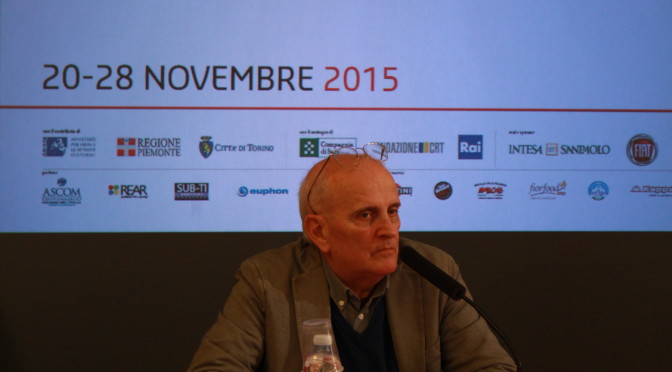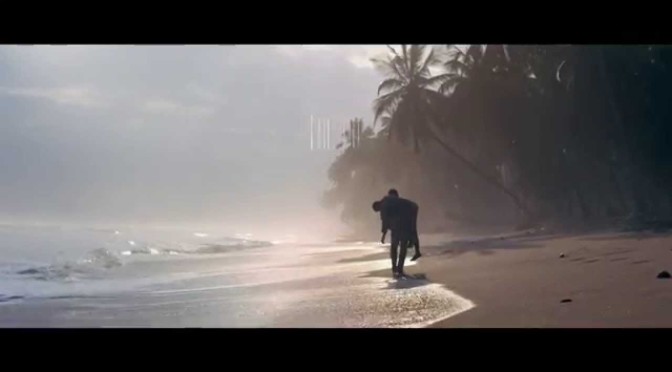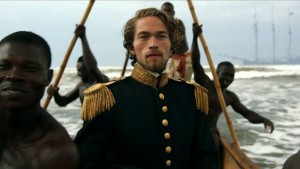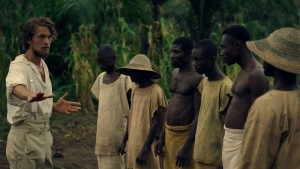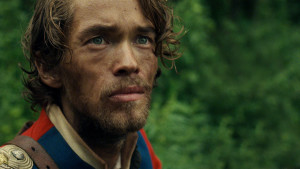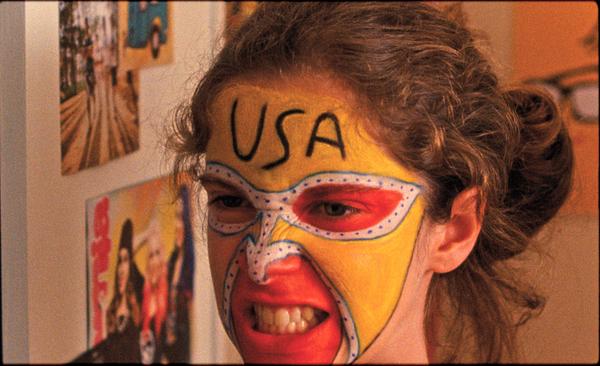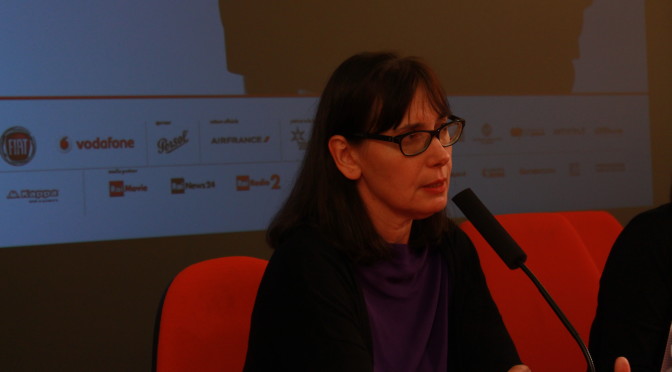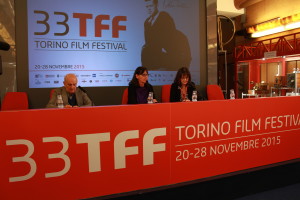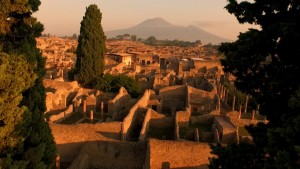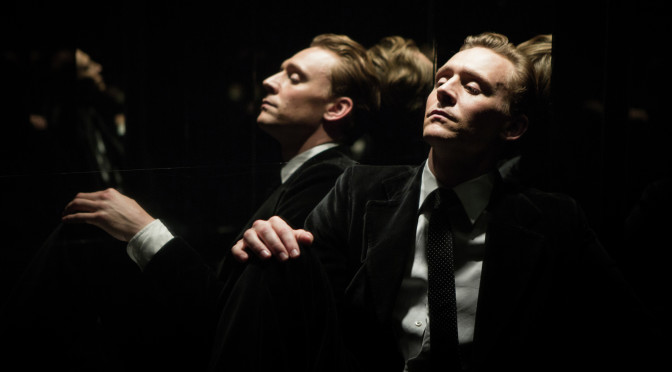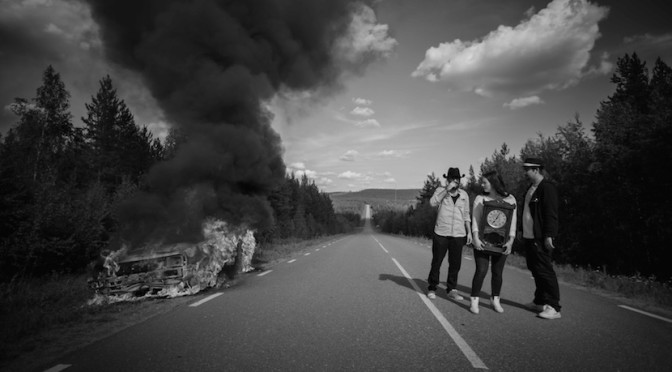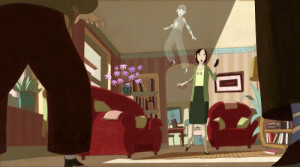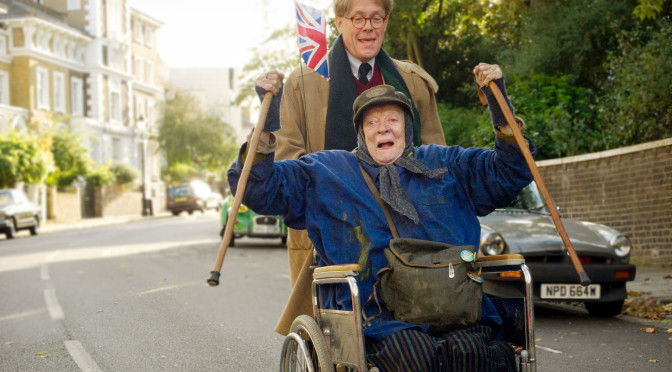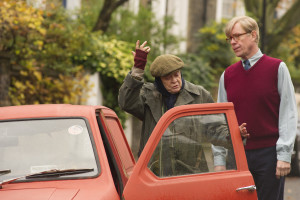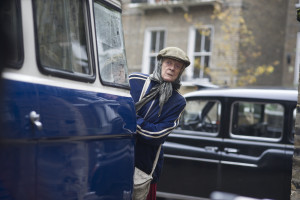Norvegia. Una piccola città su un fiordo è minacciata da una montagna che rischia di franare da un momento all’altro. Ciò causerebbe uno tsunami che distruggerebbe la ridente cittadina. Solo il geologo Kristian prende sul serio la minaccia. Proprio quando sta per cambiare vita e lavoro accade la catastrofe.
“London Road”di Rufus Norris – Conferenza Stampa
Ieri alle 13:00 in Sala Stampa nei locali della Rai, l’ultima conferenza stampa della giornata vedeva protagonista London Road di Rufus Norris. Erano presenti Adam Cork, autore delle musiche, e Alecky Blythe, la sceneggiatrice. Entrambi hanno curato l’allestimento sia del musical che del film. Se il trasformare in musical un evento così tragico come quello di cinque omicidi di prostitute (realmente accaduti a Ipswick) meritava attenzione, ancora più attenzione era necessaria nel momento in cui questo evento veniva trasposto al cinema. “Lo spettacolo nasce come spettacolo teatrale ma questo non ci ha esentato dalla responsabilità di riflettere in quest’opera uno spaccato di vita reale. Normalmente al musical si associa la commedia, numeri di danza, canzoni d’amore e tutta una spettacolarità che invece in London Road non troviamo. La nostra preoccupazione principale è stata quella di essere fedeli e rispettosi nei confronti delle vittime degli omicidi ma anche nei confronti degli intervistati che avevano affidato la loro testimonianza ad Alecky” ha dichiarato Cork.
Il lavoro di Cork e Blythe è stato quello di rendere esattamente non solo le parole dei residenti di London Road ma anche la modalità nella quale erano state espresse. Alecky Blythe adotta infatti, in teatro, la tecnica verbatim: cioè la riproduzione letterale delle dichiarazioni rese da testimoni con tutte le variazioni della voce di chi parla, il tono e le esitazioni. Questo andamento ritmico della voce ha richiesto una strutturazione melodica e ritmica sia per i dialoghi recitati che per i dialoghi cantati: una vera e propria partitura in cui alle parole recitate si è soprapposto un accompagnamento musicale che le ha trasformate in “canzoni”.
Adam Cork ha sottolineato che la transizione dal palcoscenico teatrale allo schermo cinematografico lo preoccupava molto anche in considerazione del successo che aveva avuto il musical, perché temeva la perdita di immediatezza tra gli attori e gli spettatori: “Il cinema ha il suo quarto muro che è lo schermo e temevamo che questo avesse un impatto molto forte sull’interazione tra il pubblico e gli attori. Poi però la riflessione che abbiamo fatto a posteriori è che ciascuno di noi è molto più abituato a vedere una rappresentazione drammatica su uno schermo piuttosto che in teatro: la televisione la guardiamo tutte le sere, a teatro non andiamo tutte le sere, e quindi abbiamo capito che sarebbe stato più facile per il pubblico riuscire ad assorbire una tessitura documentaristica in una forma filmica, più immediata, rispetto a quella teatrale ”.
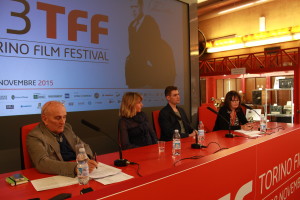
Alecky Blythe non è stata solo la sceneggiatrice di London Road per il teatro e per il cinema, ma si è anche occupata di condurre e montare le interviste. Ha raccontato di essersi recata a Ipswich nel 2006, quando erano già stati rivenuti i corpi delle cinque prostitute: “Sono andata con il mio registratore raccogliendo le testimonianze di persone che avevano vissuto, più o meno direttamente, i terribili eventi. Ipswick è una città piccola, la popolazione era scioccata dai fatti che avevano gettato scompiglio in una situazione di apparente tranquillità: c’era un assassino latitante, problemi di droga e di prostituzione”.
A seguito degli omicidi, London Road si è trasformata da strada tranquilla a comunità spaventata che organizza turni di sorveglianza notturna. Nei due anni successivi la Blythe è tornata più volte a Ipswick e il suo interesse è passato dai cittadini di Ipswich ai residenti di London Road, perché nel frattempo Steve Wright era stato arrestato come responsabile degli omicidi e si era scoperto che viveva in quella strada divenuta ormai il punto centrale del “quartiere a luci rosse” di Ipswich. “Il lavoro che ho fatto, in teatro e in cinema, è stato diverso perché la sceneggiatura cinematografica ha esigenze diverse partendo dal fatto che mantengo le parole cosi come sono state dette durante le dichiarazioni. Nel film ho dovuto ridurre i dialoghi perché il racconto avveniva anche per immagini: ho rinunciato a una parte dei dialoghi, ma non ho rinunciato alla caratterizzazione dei dialoghi, al sapore della testimonianza resa” ha precisato Alecky.
Alla domanda se ci fosse un intento di critica verso i residenti che in alcune parti del film pronunciano parole molto dure nei confronti delle prostitute, la Blythe ha risposto che non c’è mai stata nessuna volontà di criticare i residenti, né c’è stata da parte degli stessi protagonisti alcuna percezione di critica nei loro confronti: “Abbiamo cercato di essere il più possibile rispettosi della sincerità delle dichiarazioni rese dai residenti. Quando sono andata la prima volta a condurre le interviste, naturalmente, percepivo i diversi punti di vista e le tensioni che c’erano, ma tutte le loro rivelazioni erano sincere. Le dinamiche e i conflitti sono via via cambiati nel tempo: questo aveva a che fare con lo scoprire cose che avvenivano nella strada che loro non sapevano stessero avvenendo, e percepivano tutto con un senso di possesso della strada, come se qualcuno si sentisse più o meno titolato a controllarla. La sensazione che probabilmente arriva al pubblico nell’ascoltare le loro dichiarazioni è la difficoltà nel capire quello che loro hanno provato in questo percorso che poi è quello che ha generato certi toni nell’esprimere le loro opinioni. Credo che nessuno di noi che non ha vissuto gli eventi, possa capire cosa significhi avere la vita completamente stravolta”.
Durante la lavorazione del film, ha poi aggiunto Alecky, sia lei che Cork, che Norris, sono stati molto attenti a mantenere aggiornati i residenti sulle scelte effettuate e su come intendevano portare sullo schermo questa vicenda. Hanno ad esempio mostrato loro la location che avevano scelto per il film, una strada molto diversa dalla vera London Road, ma che consentiva al regista di mostrarne l’evoluzione: da strada tetra, squallida, oscura dell’inizio a strada bella e pieni di fiori che vediamo alla fine del film. La reazione da parte di tutti i residenti è stata molto positiva al punto che per la scena conclusiva del film molte delle comparse erano proprio i residenti stessi.
La reazione, invece, del pubblico italiano, come faceva notare un giornalista presente in sala stampa, è stata anche di riso in alcuni momenti del film. La sceneggiatrice ha risposto che questo è normale, e in parte anche voluto, proprio in virtù del fatto che quando lei lavora ad un progetto preferisce concentrarsi non sull’occhio del ciclone ma sulle onde che questo propaga, lasciando anche un po’ “respirare” la storia e permettere al pubblico di provare empatia e simpatia per i protagonisti. La volontà di decentrare lo sguardo è anche la motivazione alla base dell’assenza di Steve Wright sia nel musical che nel film: “Il motivo per cui sono andata a Ipswich è perché le vicende che mi stavano a cuore erano quelle della popolazione della città, in particolare dei residenti della strada, per capire come la vita di queste persone sia stata completamente sconvolta per la casualità di abitare vicino ad un serial killer. In più Steve Wright era già coperto dai media di tutto il mondo. E’ la percezione che mi hanno dato le persone che ho intervistato che volevo rendere in questo lavoro”.
Adam Cork, in chiusura, ha aggiunto che il riso spontaneo che può sorgere guardando il film non è un riso di derisione, ma appunto un riso empatico rispetto a qualcosa che il pubblico riconosce come familiare, una reazione che potrebbe avere chiunque nella medesima situazione.
Guldkysten (Gold coast) by Daniel Dencik
Article by: Giulia Tinivella Dettoni
Translation by: Roberto Gelli
Guldkysten (Gold Coast) is a film produced in 2015 by Danish director and writer Daniel Dencik and has been presented within the section Festa Mobile in TFF.
The story takes place in the first half of 19th century. A young and naive Danish botanist leaves for the African colonies in the Gold Coast, in order to check and develop local plantations, and at the same time with the purpose of studying several floral species in those savage places, which are still unknown. Once he reaches the colonies, he is amazed by the enchanted nature of its forests and meets black people, towards whom he feels at the beginning a sense of superiority, soon replaced by the idea that there are no differences between they and him. He witnesses the disgusting behavior of the colony governor and his vices towards local women and men, who have to endure any kind of wickedness and vulgarity. As time goes by, he becomes a visionary: he dreams of a world without slavery, in which he could educate local people, in order to let them progress. But no one is going to support him.
One day he discovers that a rich black merchant traffics in slaves. He furiously decides to intervene and stop that slave trade, which was already forbidden by law, though still practiced. In spite of an illusory victory, where justice, liberty and equality finally seem to prevail, the young botanist soon finds himself alone and ends up being treated in worse conditions than those reserved to the slaves.
The director makes the movie start by showing the final scenes as a prologue: in this way, he wants to give more importance to the set up rather than to the narration. Gold Coast refers to Romanticism, a period when nature was celebrated for its vitality. We see the beautiful landscapes of Ghana (the same ones of Cobra Verde of Herzog), which are the protagonist of the film in some of its parts and represent the adoration of nature. Above all, Daniel is struck by the law regulating this savage nature: mathematical laws, not the traditional ones already known at that time. The spiral figure with its cyclic nature and its repeating is what mostly attracts him. It is part of the story’s architectural structure and works as a message telling us that in a certain way, the world will always come back to its original condition, to be what it was before.
This is a film, which shows the magnificent beauty of African nature but at the same time, it points out the evil of human being, who does not deserve to live in such a perfect world.
“John From” di João Nicolau
Gli anni dell’adolescenza sono i più belli e contemporaneamente i più brutti della nostra vita. Questa è una tipica frase con la quale non si sa mai se essere d’accordo o no; di certo è vero che gli anni dell’adolescenza sono quelli in cui i nostri sogni cominciano a prendere forma, a deragliare dai binari infantili verso la dura realtà. E’ un processo quasi obbligato nel percorso dall’adolescenza all’età adulta. Nel film di João Nicolau accade esattamente l’opposto.
John From by João Nicolau
Article by: Barbara Vacchetti
Translation by: Martina Taricco
Teens years are the most beautiful and the worst moments of everyone’s life at the same time: this is a classic cliché with which you never know if to agree or not. Certainly, we usually think that adolescence years are those in which our dreams start to take a more real shape and run off the rails of childhood towards the tough reality, an almost inevitable course from adolescence to adulthood. In the movie of João Nicolau we see the exact opposite of what written above.
The protagonist is Rita: she is fifteen years old and lives with her parents in a huge and odd apartment building where blue prevails. Blue are the lift doors, the mailboxes, the balconies railings. Blue is the perfect colour for the summer during which the movie is set. Perennially on the edge of boredom that is going to submerge her, Rita spends summer walking through the city, playing the pipe organ in a recreation centre and going to parties with her friend, who lives in the same building with which she exchanges some messages written on slips of paper that they hide in the lift.
To break up the monotony of this hot summer, a new neighbour comes: a man who is about thirty-five with his little daughter who has to provide for. His name almost eludes the audience attention because very soon, this absent-minded photographer calls the attention of Rita. Nonetheless, the girl does not see him as he truly is but as the character of the title, John From.
Aided by the fact that the photographer is exhibiting the pictures that he shot in Melanesia, Rita starts to imagine him as the god John From that, according to Melanesian legends, is described as an American soldier “fallen from the sky”. Rita connects this legend to her new neighbour, fallen from the sky as well, like a blessing or a potion against the boredom. Therefore, the attempts of Rita to approach him begin but they all end in inconclusive meetings.
In the midst of her daydreaming, Rita starts to mix up what really happens with what she would like to happen; the boundaries between reality and imagination becomes more and more weak until they merge together. It is therefore difficoult to distinguish the reality from the dream, so that when we are in love, an ordinary wave becomes a sign of fate. Rita plays a game: she questions her iPod, close her eyes, browse the songs then she stops at random and the title of the song should tell her the answer to her question.
Nicolau shows us this adolescent world in a disenchanted and realistic way, dressed up with a touch of irony that could make the movie irresistible. A world in which the parents are distant but caring all the same, teenagers are mature thanks to their experiences and disappointments and an ordinary crush could turns into an endless dream of a wedding and beach games.
“Guldkysten” (“Gold Coast”) di Daniel Dencik
Guldkysten ( Gold Coast), un film del 2015, del regista e scrittore danese Daniel Dencik, è stato presentato nella sezione Festa Mobile del Festival.
Continua la lettura di “Guldkysten” (“Gold Coast”) di Daniel Dencik
“Evolution” di Lucile Hadzihalilovic – Conferenza stampa
Alla domanda “Quali sono i registi che più l’hanno influenzata?” risuonano nella sala due nomi: Dario Argento e David Cronenberg. Questa la risposta che Lucile Hadzihalilovic dà ai giornalisti durante la Conferenza stampa tenutasi oggi 24 Novembre riguardo il suo nuovo film Evolution. Suoi Maestri sono Dario Argento per la sua concezione di horror e per la scelta delle locations, David Cronenberg per la capacità di riprodurre sullo schermo le metamorfosi del corpo. Aggiunge anche che le letture dei miti classici da cui ha tratto l’idea delle creature marine, e degli scritti di Howard Philips Lovecraft sono state fondamentali per la realizzazione del film.
Dopo Innocence del 2004, ambientato in una scuola isolata dal mondo frequentata da innocenti bambine, in Evolution vi sono solo donne e bambini. La regista francese dichiara che la mancanza di uomini nel film accentua maggiormente il suo aspetto orrifico perché nessuno può contrastare le donne che, schiavizzando i bambini, li usano a loro piacimento provocando il loro smarrimento. I personaggi sono rinchiusi in un mondo claustrofobico. L’ambientazione buia e che non lascia respiro rende il racconto terrificante.
Il progetto originale di Evolution prevedeva un numero maggiore di elementi fantascientifici poi accantonati a causa dello scarso budget a disposizione. Sono numerose, invece, le immagini crude che danno una rappresentazione realistica della situazione (forse scorie del cinema di Gaspar Noé – il quale tra l’altro è suo marito).
Evolution è il frutto di angosce personali ma anche un tentativo di risposta alle teorie darwiniane proponendo una visione della Terra abitata da altre creature oltre l’essere umano.
“Heterophobia” di Goyo Anchou
Dopo la visione del bellissimo cortometraggio di Pappi Corsicato Pompei Eternal Emotion, qualcuno del pubblico lascia la sala, altri sono intimoriti dal prossimo film o forse solo dal suo titolo: Heterophobia. Cala il buio. Appare un personaggio, Mariano, che si masturba. Altri spettatori se ne vanno, schegge di perbenismo lasciano la sala. Mariano per un minuto è amore meccanico. Così si apre Heterophobia, “una rapsodia antipatriarcale”, lungometraggio di Goyo Anchou.
Pompei Eternal Emotion by Pappi Corsicato
Article by: Alessandro Arpa
Translation by: Cristiana Caffiero
Pompei Eternal Emotion is the new production by Pappi Corsicato. It’s a short cut which lasts about 10 minutes about Pompei, its archeological sites where we can find some bodies petrified by magma. The bodies of the tourists appear hibernated as well: they are puppets without life that turn into victims of the camera. In the several rooms there are some shells without soul. This short cut is really memorable….memorable is the right word to indicate it if we consider the disasters which have occurred in Pompei in 2014 which have destroyed an important part of our artistic heritage.
Anyway what will be next is even more amazing. After Corsicato’s movie, someone in the audience stands up to move away while those who are still inside the cinema are someway frightened by the movie that will follow. Maybe it’s just because of its title: Heterophobia. Just few brave ones among the audience have stayed. It’ s dark in the theatre. From the screen there’s a light arising towards the audience: Mariano who masturbates. Then some other people step out of the theatre. They looked disgusted by what they have just happened to watch on the screen: this is what it’s defined as self-righteousness. For about one minute Mariano is what we can call mechanical love. This is the way Heterophobia starts. It soon turns into an anti patriarchal rhapsody. Heterophobia is a movie directed by Goyo Anchou. Mariano is a young guy who has been raped. He represents a vile puppet of a kind of heterosexual illusion. He has to face the strong caste of society, which is represented by patriarchy according to the Argentinian director. Patriarchy rapes people with its rude aggression. The main character is a small part of the entire universe, a small being created by God who looks for a small place for himself in the world. Mariano denies himself: he just steps from one love to another, he’s not reciprocated and his fate is disillusion and frustration. He has a main relationship with an heterosexual who abandons him at the end. Mariano thinks that God doesn’t care about his creatures and suddenly turns into Satanist. He takes part into an initiation ceremony which is wonderfully described by the Argentinian director: Masonic and Cabalhistic symbols, images from movies such as Cabiria by Pastrone, Maciste in hell by Freda, Zasie dans le metro by Malle. This movie combines some quotes from classic movies as well as dreamlike, hypnotic images that hint to Kenneth Anger or Derek Jarman. After Un chant d’amour by Jean Genet, Heterophobia can be considered the new manifesto of the homosexual culture. Mariano understands that it’s a nonsense to look for happiness in other people or to be a frustrated heterosexual. He comes to understand that to accept oneself is the way to happiness and freedom. Now Mariano is happy with his new boyfriend. He has come to a safe rescue towards a future where homosexuality won’t be a taboo anymore, machismo will turn into nonsense and people will feel free to abolish the so called boring normality.
“High Rise” di Ben Wheatley
Il film è l’adattamento cinematografico del romanzo Il condominio di James Graham Ballard. Il premio Oscar Jeremy Thomas era da anni interessato alla realizzazione di questo film, è riuscito però a produrlo solo nel 2014.
Presentato in anteprima al Toronto International Film Festival, poi in concorso al Festival di San Sebastián, High Rise arriva al TFF e viene proposto nella sezione Festa Mobile, dedicata alle opere fuori concorso e inedite in Italia, che esprimono il meglio della produzione cinematografia internazionale.
High Rise by Ben Wheatley
Article by: Lorenzo Trombi
Translation by: Roberto Gelli
The movie is the screen adaptation of the novel High Rise, written by James Graham Ballard. Jeremy Thomas, winner of the Academy Award, had been interested for year in making a film from Ballard’s novel but he only succeeded in producing it in 2014.
After showing a preview of High Rise at Toronto International Film Festival, the film was presented at San Sebastián International Film Festival and now it arrives at TFF within Festa Mobile section, reserved to non-competing films and unreleased films in Italy, which represent the best international movie production.
The movie is rich in rather interesting visual solutions such as the different kinds of oppressive verticality related to the skyscraper itself, where the story takes place. These are well conveyed by oblique and sloping framing or by the protagonist movements surrounded by the lift’s mirror but the film is not able to completely overcome the difficulties to cinematographically render situations and atmospheres implied in Ballard’s novel, in which we find different levels.
The screen challenge was perhaps to shape that metaphor of modern society, where everyone has the same role of tormentor and victim. The represented microcosm is located in a skyscraper, which offers every kind of thing people may need.
Most of the characters never leave the building except for the new surgeon, the protagonist Robert Laing, who in the first part of the film goes out to work. But in the end, after the tumultuous events have ceased, we will see him starting his professional activity within the skyscraper.
Often, the residents are referred to by mentioning their room numbers, as it happens in the dialogue between Laing and the architect during the squash match. This is clearly a sort of obsessive depersonalization.
Let’s step back and have a look at the plot. It all starts with the new surgeon moving in a luxury flat in the skyscraper. It won’t be long till he realizes the social distribution taking place throughout the building: the poorer classes live downstairs while wealthy people stay upstairs. The architect even invites him to visit his extra luxury attic but Laing looks indifferent and he only seems to be interested in seducing women.
During a blackout things become chaotic and everyone starts to understand that the more they go upstairs, the better they feel. This “physical” rise corresponds to a “moral” transformation: the majority of them become greed and fight with one another. One of the main female characters explains to her husband her sense of suffocation and tells him that she would like to enjoy the same light that those in the upper floors have at their disposal. Documentary filmmaker Richard Wilder heads the uprising with the aim of killing the architect.
In the last scenes we hear a speech saying that capitalism will never allow political liberty.
However, the film mood is oppressed by a script, which sometimes aims to be overfilled with facts and dynamics. The characters take themselves too much seriously and there is a lack of whatever possible temporary break out and lightness, which could reduce its general claustrophobia. Almost all of the film is made of internal shooting.
There are a lot of narrative premises in the movie but their developments lead too much towards a dead end track.
For sure, High Rise is worth seeing again, in order to ponder its content.
“Phantom Boy” di Jean-Loup Felicioli e Alain Gagnol
“Mi chiamo Leo, ho 11 anni e ho un segreto… Sono un eroe.”
Phantom Boy è un film d’animazione che racconta la storia di un bambino malato di leucemia il quale scopre di possedere un potere: può staccarsi dal suo corpo e volare come un fantasma. Invisibile agli occhi di tutti, Leo attraversa i muri dell’ospedale e svolazza libero per la città di New York.
Continua la lettura di “Phantom Boy” di Jean-Loup Felicioli e Alain Gagnol
“Sophelikoptern” (“The Garbage Helicopter”) di Jonas Selberg Augustsén
Sophelikoptern (The Garbage Helicopter) è un curioso film del regista svedese Jonas Selberg Augustsén, presentato nella sezione TorinoFilmLab del Festival.
La sequenza iniziale ci mostra una piattaforma d’atterraggio immersa in una fitta foresta nordica, sulla quale viene sganciato un enorme container da un elicottero che sentiamo, ma non vediamo. A seguire si cambia ambientazione: un’anziana signora all’interno della propria camera si accorge di non poter più fare a meno, dopo un anno di attesa, del suo orologio ora in riparazione; alza il telefono, chiama la nipote dall’altra parte della Svezia e chiede di riportarglielo. Inizia così il viaggio della nipote, di suo fratello e di un amico attraverso tutto il Paese.
Continua la lettura di “Sophelikoptern” (“The Garbage Helicopter”) di Jonas Selberg Augustsén
Phantom Boy by Jean-Loup Felicioli and Alain Gagnol
Article by: Elisa Cocco
Translation by: Chiara Toscan
“My name is Leo, I’m 11 and I have a secret… I’m a hero.”

This is the second animated film after A Cat in Paris (2010) by Jean-Loup Felicioni and Alain Gagnol. The film tackles subjects such as illnesses, childhood and bravery. A serious disease affects an eleven-year-old child upsetting his boyhood, the most beautiful period in life. However, his courage is the element that stands out in the film: Leo decides to help Alex and Mary with their investigation, at the extent he sacrifices himself for their sake. He proves to be brave facing his illness and, at the end of the film, when he decides to stay with Mary even if it might preclude him the chance to rejoin with his material body.

“Fahrenheit 451” di François Truffaut
Tratto dal romanzo omonimo di Ray Bradbury, il lungometraggio del 1966 diretto da François Truffaut s’inserisce nella retrospettiva “Cose che verranno”.
La società prospettata nel film, in un futuro non ben definibile, prevede un divieto assoluto e tremendo: leggere libri. Questi sono vietati, messi al bando, e se trovati, bruciati dai pompieri che non spengono incendi, ma li provocano. E’ proprio uno di loro il protagonista del film, un tranquillo esecutore di ordini che ha deciso di non porsi alcuna domanda sul perché debba mettere in atto questa barbarie. Sarà l’incontro con una vicina di casa, un’insegnante lettrice clandestina, a instillare in lui dei dubbi e infine un impeto rivoluzionario che cambieranno per sempre la sua esistenza.
Continua la lettura di “Fahrenheit 451” di François Truffaut
“The Lady in the Van” di Nicholas Hytner
Mary Shepherd (interpretata da una fantastica Maggie Smith) è una vivace donna anziana che vive dentro il suo caro, vecchio e puzzolente furgone. Vaga gironzolando per le strade di Londra in cerca di un posto sicuro dove stare, fino a quando non arriva a Camden Town, un quartiere nel Nord della città. Qui la gente si dimostra subito gentile nei suoi confronti, nonostante l’odore che porta con sé davanti alle loro case.
Continua la lettura di “The Lady in the Van” di Nicholas Hytner
The Lady in the Van by Nicholas Hytner
Article by: Elisa Cocco
Translation by: Chiara Toscan
Mary Shepherd (wonderfully interpreted by Maggie Smith) is a lively elderly woman who lives in her dear old smelly van. She wonders around the streets of London, seeking for a safe place to live, until she get to Camden Town, an inner district in the north of the city. Here, people prove to be kind to her, especially when she settles with her van, despite the smell it brings in front of their homes.

The comedy writer Alan Bennet (interpreted by Alex Jennings) has just bought a house in the neighborhood and immediately notices the presence of the battered van, parked in the lane, and the eccentric woman who inhabits it.
When on-street parking becomes forbidden, Miss Shepherd finds herself without a place to park her van, and the writer, a restrained but kind man, invites her to settle temporarily in his driveway. However, the provisional arrangement becomes permanent: “I was supposed to stay here for three months, but I ended up staying fifteen years!” says Mary at the end of the film while laughing out loud; years in which their beautiful friendship develops, even including arguments and misunderstandings, just like an old married couple.
In Nicholas Hytner’s film there are two versions of Alan Bennett: one who lives his life, and the other who writes about it. The story is mostly true and is about an author who struggles with a creative block while trying to find himself. But the film is also the story of a friendship which turns an unknown vagabond into “one of the family”.
Presented at the festival’s section “Festa Mobile”, The Lady in the Van is adapted from Alan Bennett’s play and his autobiographical book. The writer, who is also the screenwriter of the film, played a walk-on part in the final scene.
The Lady in the Van is a pleasant film that leaves place for reflections while teaching to look beyond appearances, because behind the clothes (or the smell) there is always a hidden story.
“Akira” di Katsuhiro Ôtomo
Neo Tokyo, 2019. Dopo la Terza Guerra Mondiale il Giappone è in crisi. Economia allo sbando, politica corrotta e inefficace non riescono a trovare il modo di far ripartire un Paese in cui il crimine e la violenza la fanno da padrone. Unica cosa che sembra importare al Governo è Akira, sorta di progetto segretissimo volto al controllo di un potere enorme, che ha causato il proliferare di sette di invasati in tutta la città, i quqli predicano l’avvento di una divinità chiamata Akira. In questo caos sfrecciano su bolidi truccati gang di motociclisti, tra cui anche Kaneda e Tetsuo, ma un incidente inaspettato durante una scorribanda notturna come tante cambia per sempre le loro vite e quelle dell’intera nazione.
Akira by Katsuhiro Ôtomo
Article by: Matteo Merlano
Translation by: Kim Turconi
Neo Tokyo, 2019. After the third World War, Japan is in crisis. Economy in ruin in addition to corrupted and ineffective politics cannot find a way to start up again a Nation where crime and violence rule the roost. The only thing which seems to be of a certain relevance to the government is the Akira Project, sort of super secret project intended to control an enormous power, which has caused sects of obsessed people to flourish all around the city, preaching the arrival of a divinity called Akira. In this chaos, gangs of bikers speed across the city on modified beasts. Among them there are Kaneda and Tetsuo. An unexpected accident during one of the many raids, will change their lives and those of the entire nation forever.
Undisputed masterpiece of Japanese animation, the movie of Katsuito Otomo is not just a cinematographic opera, but a whole experience, leaving the audience breathless. Produced in 1988 (in Italy came out only in 1992) it was the most expensive anime in History (with a budget of one billion yens) and brought to the creation of a specific production house to realize it, the Akira Committee, with Otomo himself as the chairman, who employed for years more than one thousand animators. All the fears and the contradictions of that decade are contained in this dystopia which draws fully from western cult movies. An elaborate, chaotic and colossal Neo Tokyo is the spitting image of the rainy Los Angeles from Blade Runner (the time of setting is, for this reason, not randomly chosen) ruled by lawless riders (Mad Max) who go all around the city on futuristic bikes (Kaneda’s motorcycle design is identical to the lightcycles from Tron). The aesthetic magnificence is something which leaves everyone amazed and the masterly sound work, overseen by composer Shoji Yamashiro, was an epochal evolution in the animation field.
The concept of Evolution itself is the base of Akira. What is this mysterious energy, so devastating that it needs to be hidden in the bowels of the earth? Who controls it? Where it comes from? Who owns it and how can it be used? The spiritual aspect of the film lies in this ambivalence of the concept of Evolution – especially technological evolution – which often leads to a regression when technology goes too far.
Is it creative or destructive? Otomo is certainly a son of Hiroshima and Nagasaki. That “sun” – which kills tens of thousands people in a few seconds – has affected his worldview. Evolution is a powerful force, but it can cause pain if mishandled. Akira embodies this philosophy and make it to burst with an explosion of visual effects and visionary experiences that leave an impression on one’s mind. The future portrayed by Otomo is crazy, chaotic and illuminated only by neon signs and skyscrapers lights. It is a future in which people run at full speed without any purpose, or they run for the wrong reasons.
The title of this review is taken from the famous Blade Runner monologue of Roy Batty/Rutger Hauer. Our choice has not been accidental, because the Future is already here – and perhaps already experienced. Otomo, just like Scott, “has seen things”. And we have seen them with him.
“La Patota – Paulina” di Santiago Mitre
Santiago Mitre, dopo il successo di El estudiante, vincitore del Gran Premio della giuria al Festival di Locarno 2012, arriva sulla scena torinese con quest’opera seconda, La Patota –Paulina, film in concorso nella corrente edizione del Festival. Al regista è bastata una sola visione del film Patota (1961) di Daniel Tinayre per rimanere colpito dal personaggio di Paulina e accettare di dirigerne il remake.
Continua la lettura di “La Patota – Paulina” di Santiago Mitre


